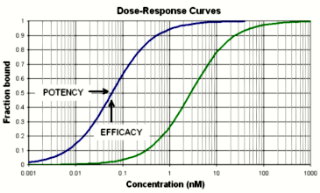Contents |
Drug action
Desired activity
The desired activity of a drug is mainly due to one of the following:
- Cellular membrane disruption
Chemical reaction
Interaction with enzyme proteins
Interaction with structural proteins
Interaction with carrier proteins
Interaction with ion channels -
Ligand binding to receptors:
- Hormone receptors
- Neuromodulator receptors
Neurotransmitter receptors
General anesthetics are believed to work by disordering the neural membranes, thereby altering the Na+ influx. Antacids and chelating agents combine chemically in the body. Enzyme-substrate binding is a way to alter the production or metabolism of key endogenous chemicals, for example aspirin irreversibly inhibits the enzyme prostaglandin synthetase (cyclooxygenase) thereby preventing inflammatory response. Colchicine, a drug for gout, interferes with the function of the structural protein tubulin, while Digitalis, a drug still used in heart failure, inhibits the activity of the carrier molecule, Na-K-ATPase pump. The widest class of drugs act as ligands which bind to receptors which determine cellular effects. Upon drug binding, receptors can elicit their normal action (agonist), blocked action (antagonist), or even action opposite to normal (anti-agonist).
In principle, a pharmacologist would aim for a certain plasma concentration of the drug for a desired level of response. In reality, there are many factors affecting this goal. Pharmacokinetic factors determine peak concentrations, and levels cannot be maintained with absolute consistency because of metabolic breakdown and excretory clearance. Genetic factors may exist which would alter metabolism or drug action itself, and a patient's immediate status may also affect indicated dosage.
Undesirable effects
Undesirable effects of a drug include:
- Increased probability of cell mutation (carcinogenic activity)
- A multitude of simultaneous assorted actions which may be deleterious
- Interaction (additive, multiplicative, or metabolic)
- Induced physiological damage, or abnormal chronic conditions
Receptor binding
The binding of ligands (drug) to receptors is governed by the law of mass action which relates the large-scale status to the rate of numerous molecular processes. The rates of formation and un-formation can be used to determine the equilibrium concentration of bound receptors. Although the receptors are fixed to a 2-dimensional membrane, an arbitrary control volume can be used to calculate the dissociation constant,
where L=ligand, R=receptor, square brackets [] denote concentration. The fraction of bound receptors is found as (1+[R]/[L·R])-1 , which can then be expressed using Kd as,

This expression is one way to consider the efficacy of a drug, in which the response may be directly proportional to the fraction of bound receptors. Often the response is determined as a function of log[L] to consider many orders of dosage range. It is useful to note that 50% of the receptors are bound when [L]=Kd .
A plot of the function for the bound fraction of receptors forms a typical model for the dose response of a drug. The graph shown represents the dose-response for two hypothetical receptor agonists, plotted in a semi-log fashion. The curve toward the left represents a higher potency (potency arrow does not indicate direction of increase) since lower concentrations are needed for a given response. The efficacy increases as a function of concentration.
Multicellular pharmacodynamics
The concept of pharmacodynamics has been expanded to include Multicellular Pharmacodynamics (MCPD). MCPD is the study of the static and dynamic properties and relationships between a set of drugs and a dynamic and diverse multicellular 4 dimensional organization. It is the study of the workings of a drug on a minimal multicellular system (mMCS), both in vivo and in silico. Networked Multicellular Pharmacodynamics (Net-MCPD) further extends the concept of MCPD to model regulatory genomic networks together with signal transduction pathways, as part of a complex of interacting components in the cell. For a fuller explanation of these concepts see the articles:
- Jackson, R.C. (2003) Predictive software for drug design and development. Pharmaceutical Development and Regulation 1 ((3)), 159-168.
- Werner, E., In silico multicellular systems biology and minimal genomes, DDT vol 8, no 24, pp 1121-1127, Dec 2003. (Introduces the concepts MCPD and Net-MCPD)
A good source for further information and posting to experts can be found courtesy of Dr. David W. A. Bourne, OU College of Pharmacy [1].




 216.73.216.81
216.73.216.81 User Stats:
User Stats:
 Today: 0
Today: 0 Yesterday: 0
Yesterday: 0 This Month: 0
This Month: 0 This Year: 0
This Year: 0 Total Users: 117
Total Users: 117 New Members:
New Members:
 216.73.xxx.xx
216.73.xxx.xx
 Server Time:
Server Time:![K_d = \frac{[L][R]}{[L\! \cdot \!R]}](./modules/Drugs-MM/images/cfb1b0beb4fdfb3f00a7718e79a8ac82.png)
![Fraction \ Bound = \frac{1}{1+\frac{K_d}{[L]}}](./modules/Drugs-MM/images/62e1c65d042c3132e4f1ac972e108279.png)
